| CPC H04L 41/142 (2013.01) [G06F 18/22 (2023.01); G06F 18/23 (2023.01)] | 19 Claims |

|
1. A method for managing network event data in a telecommunication network, the network event data being associated with products provided by different vendors, the method comprising:
obtaining a plurality of datasets, each dataset comprising network event data associated with products provided by a single vendor, and each dataset comprising a plurality of data instances representing a plurality of network event features;
obtaining metadata describing the network event data in the datasets;
for individual network event features represented in the datasets, generating a feature description vector from the obtained metadata;
calculating, on the basis of the generated feature description vectors, a metric of the relation between network event features represented in the datasets, the calculating comprising computing a pairwise similarity between the feature description vectors of the network event features represented in the datasets;
constructing a graph of the network event features represented in the datasets, wherein edges between the network event features are weighted according to the calculated metric;
partitioning the graph into clusters by minimising an edge cut between network event features;
for individual clusters in the graph, labelling network event features in the cluster with a normalised network event feature index, which index is unique to the cluster and corresponds to a specific normalised network event feature; and
inputting the network event data representing the labelled network event features to a model for making at least one of recommendations or predictions based on input data representing normalised network event features.
|